 Indians Archive
Indians Archive  Tribe Game Vault: 6/18/79. The Night We Cheered Orioles Mgr. Earl Weaver
Tribe Game Vault: 6/18/79. The Night We Cheered Orioles Mgr. Earl Weaver
With the news of the sudden passing of Earl Weaver, The Cleveland Fan fondly recalls a game he managed at Cleveland Stadium.
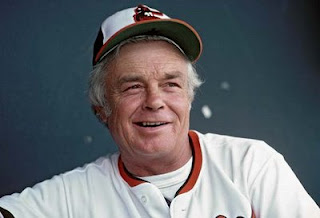
Have you ever attended a baseball game because of the opposing manager? Or at least considered the game as must-see TV? I can count on one hand the particular ballplayers I have gravitated toward in such a manner. Hank Aaron, as a visiting Milwaukee Brewer during the twilight of his career. Bo Jackson, for sure. Speed… power… even him snapping his bat in two after a frustrating strikeout got the crowd stirring. For Tribe fans of the 90s, of course, the team didn’t just spoil us with wins. Nobody wanted to miss the drama of Albert Belle’s or Jim Thome’s next “majestic blast” (in the words of play-by-play man Tom Hamilton). Likewise, the havoc Kenny Lofton could wreak on the base paths commanded fans’ attention.
A figure need not necessarily be famous to be compelling. A friend of mine was talking about one of his favorite Indians players from about thirty years ago. Let’s see if you can guess who it is before I tell you.
“Well, back in the day you only saw 70 to 80 games or so on TV if my memory is correct. I would get the TV guide (remember that?), and check the schedule for my Tribe games for the week. I had to plan my schedule around the Indians, including the day games on the weekends. The teams were bad and besides Andy and Toby nobody could hit. I would turn on the game, which I may have looked forward to all week. Since the Tribe was typically on the road for telecasts, who would start off the game- why, my main man ------, of course.
I would sit there and say, get-on-base-get-on-base. Uh oh, he’s on base -now the fun begins. When is he going to take off for second? There’s the pitch, there he goes, strike, the throw to second, the slide …. SAFE!!!!! YES!!!!! Then after Andy is walked, he is stranded at second, and the Tribe goes on to lose 3-2. Ha ha You know, they actually had some great pitching and decent ball clubs. .500 ball clubs, but before the divisional splits that didn’t put you in contention for the playoffs.”
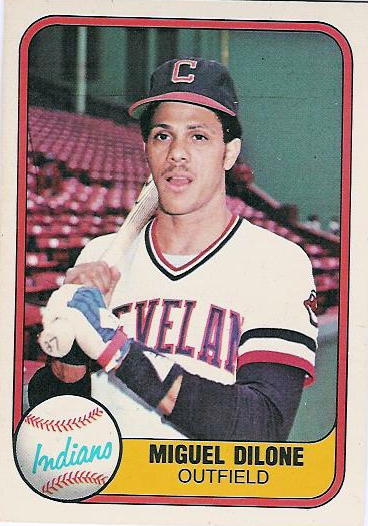 If you read that and thought of Miguel Dilone, you are a winner!! Be sure to let this web site know and we will send you a brand new…
If you read that and thought of Miguel Dilone, you are a winner!! Be sure to let this web site know and we will send you a brand new…
Well, what you’ll actually have won is some serious Tribe street cred. Congratulations! (My wife warns me that sometimes, I am the only one who thinks I am funny. Which amuses me.)
Even though cable and ESPN were on the immediate horizon, the print media was still king of sports publicity and hype in 1979. Local newspaper beat writers virtually lived with ball clubs when they were on the road, and almost all of the news consumed by the public filtered through them. Local television sportscasters also played a role. On a national level, there were one or two TV programs that highlighted major league baseball. But again, the print media reigned. The Sporting News. Sport Magazine. Baseball Digest. And perhaps the top publication, the weekly Sports Illustrated (shoot, they didn’t even need to show semi-naked women to sell magazines back then).
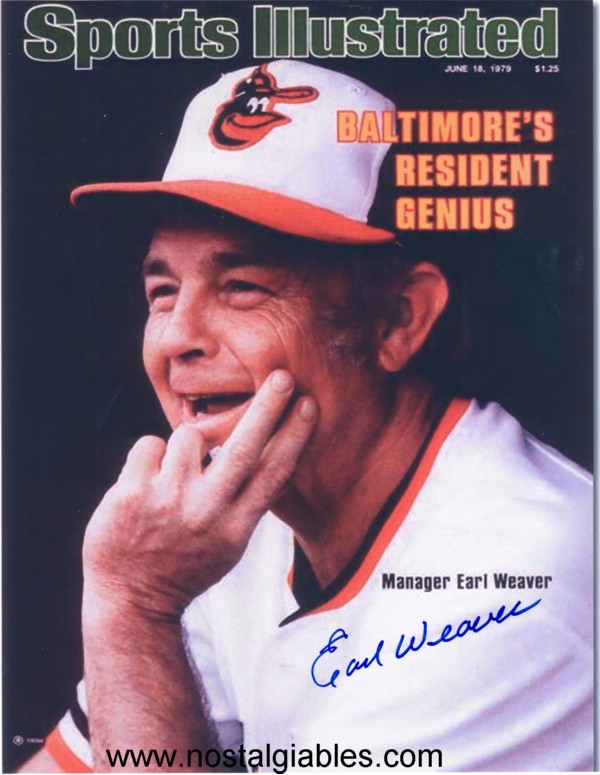 The cover of Sports Illustrated for the week of 6/18/79 was Baltimore Orioles manager Earl Weaver. "Baltimore's Resident Genius." His first-place club was winning about two thirds of its games, and was accustomed to pennant contention in the 70s. The days of 1B Boog Powell, 3B Brooks and RF Frank Robinson, and SS Mark Belanger were gone, but the present-day Orioles boasted 1B Eddie Murray, RF Kenny Singleton and C Rick Dempsey. Of course, as with all Weaver ball clubs, the pitching was the heart and soul of the team. In the past, it had been the last foursome of 20-game winners on the club, in Palmer, Cuellar, McNally and Dobson. Now, it was future Tribe starter Dennis Martinez, Scott McGregor, Cleveland native Steve Stone and 1979 American League Cy Young Award winner, Mike Flanagan. One of the constants was the manager.
The cover of Sports Illustrated for the week of 6/18/79 was Baltimore Orioles manager Earl Weaver. "Baltimore's Resident Genius." His first-place club was winning about two thirds of its games, and was accustomed to pennant contention in the 70s. The days of 1B Boog Powell, 3B Brooks and RF Frank Robinson, and SS Mark Belanger were gone, but the present-day Orioles boasted 1B Eddie Murray, RF Kenny Singleton and C Rick Dempsey. Of course, as with all Weaver ball clubs, the pitching was the heart and soul of the team. In the past, it had been the last foursome of 20-game winners on the club, in Palmer, Cuellar, McNally and Dobson. Now, it was future Tribe starter Dennis Martinez, Scott McGregor, Cleveland native Steve Stone and 1979 American League Cy Young Award winner, Mike Flanagan. One of the constants was the manager.
By 1979, Weaver’s reputation was well-established. He was a proponent of, as he often put it, “pitching, defense, and the three-run homer.” Baseball purists, especially National League observers, scoffed at Weaver’s disregard for manufacturing runs with hit-and-runs and sacrifice bunts. For his part, Weaver thought it was silly to willingly give up outs. He was known as an expert in handling a pitching staff. He commonly used starting pitchers in a relief role as they established themselves in the league. Weaver was also considered to be a master in handling his bench. He successfully employed platoons, and was a pioneer in the use of statistical splits when deciding who to play and in completing the batting order.
What Earl Weaver is most famous for was his argumentative style. His protests with umpires are legendary (bad language alert). There are plenty of YouTube videos out there on him. That’s what fans talked about. He was, dare I say, must-see TV.
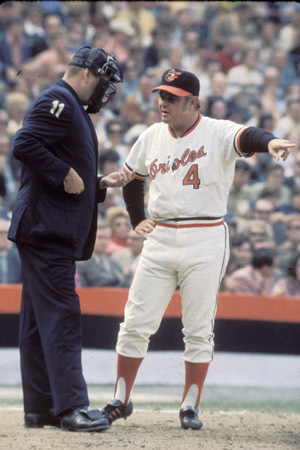 On June 18, 1979, my family was among the 21,506 who attended the evening matchup between McGregor and a Tribe pitcher who was on the comeback trail after suffering from arm trouble, Wayne Garland. The O’s were clearly the class of the American League. The Indians weren’t bad. They were a .500 team, and would remain so to the end of the season.
On June 18, 1979, my family was among the 21,506 who attended the evening matchup between McGregor and a Tribe pitcher who was on the comeback trail after suffering from arm trouble, Wayne Garland. The O’s were clearly the class of the American League. The Indians weren’t bad. They were a .500 team, and would remain so to the end of the season.
We were seated on the third base side, in the upper deck and down the line. Right on the fringe of the crowd in the ‘old barn’, where we could stretch out and relax a bit. I cannot recall why we weren’t in our customary area near the right field foul pole (near Gate D, which welcomed East Siders in particular). It was somewhat of a treat, catching the pennant contending Orioles.
Garland got through the top of the 1st inning unscathed after allowing a leadoff single and stolen base to CF Al Bumbry. In their half of the 1st, Tribe RF Bobby Bonds hit a one-out home run, scoring 3B Toby Harrah. 2-0 Indians.
Orioles 2b Billy Smith cracked a homer to lead off the 3rd. After a Dempsey strikeout, Bumbry worked a walk and stole second again. SS Kiko Garcia singled, and Singleton hit a sacrifice fly to right. Bonds uncorked a horrible throw to the plate, and Garcia scored as well. 3-2 Orioles.
Baltimore scored another run in the 4th, on a lead-off, solo shot by LF Gary Roenicke.
They got another lead-off homer in the 5th, from Dempsey, to extend their lead to three. After a one-out single to center by Garcia, Dan Spillner was summoned to relieve Garland.
Oh, I probably should clarify: it seemed clear that the crowd had not been chanting (Tribe reliever Victor) “Cruuuuuuuuze” the entire game. No, they definitely were booing Wayne Garland.
Spillner was a stiff. Sorry. He didn’t have a bad game on this day, though. Garcia did steal second, and C Gary Alexander's tough day behind the plate continued as he launched his throw into center field. Singleton’s base hit scored Garcia. 6-2 Orioles.
In their half of the 5th, the Tribe gave the fans a thrill- they would come all the way back to tie the game. 1B Mike Hargrove homered to start the inning. 2B Dave Rosello walked. After SS Tom Veryzer was called out on strikes, CF Rick Manning walked. Harrah bunted but reached safely to load the bases.
McGregor was lifted for Sammy Stewart, who allowed singles to Bonds and Cliff Johnson; 3 runs scored. Before the 5th inning was over, Stewart had Johnson picked off of first. The big DH fell off the bag as Murray tagged him- but he was ruled safe. Murray was outraged, and argued his way into an ejection by first base umpire Fred Spenn.
So the proud, division-leading Baltimore Orioles were having trouble putting these Cleveland Indians away. Their clean up hitter, Eddie Murray, was off to the showers.
Earl Weaver simmered.
The tie was broken by the Orioles in the 7th on a run-scoring single by ex-Tribesman John Lowenstein. 7-6 Orioles. In the bottom of the 8th inning, more drama unfolded.
***What follows is my recollection of the events of the 8th inning. My memory is not contradicted by published reports I have found. However, I remember more details than I can corroborate. I do think I recall these events pretty well, however:
Mike Hargrove singled to right, and Rosello came up to bunt. It was late in the game, and the Indians needed to at least tie it up with one run. Rosello laid it down and burst toward first base. He collided with Dempsey after he left the batter’s box. He reached first safely even though he had interfered with the catcher.
Think Earl Weaver had something to offer home plate umpire Ted Hendry? Ohhhhhh, yeah. Weaver was in Hendry’s face immediately as the cheering crowd began to boo. The discussion lasted several minutes. It seemed clear that Weaver had a beef on that play. His body language became more and more animated, with his hands in his back pockets as he bobbed his head up and down in emphasis as he argued. Weaver motioned to the other umpires, trying to get them involved. He walked out to them as the crowd’s booing grew more intense.
After a few minutes of that, Weaver stormed off the field, moving with purpose. He disappeared from the field momentarily, before marching right back up to Hendry on the third base side of the pitching mound. Weaver now had a rule book in his hands. He was holding it up to the umpire’s face, turning pages and pointing to it. Shaking it. BOOOOOOOOOO.
Exasperated, Weaver began hurriedly ripping pages out of the rule book. One by one. Once he had several pages removed, he threw them up in the air. Certainly, he had been thrown out of the game by now, and he began stomping off toward his dugout once more. The crowd’s boos were mingled with some cheering.
The umpires weren’t going to retrieve Weaver's trash, of course. They couldn’t give Weaver the satisfaction. So they summoned the Cleveland grounds crew to perform the chore. Two or three of the younger grounds crew hustled on to the field, and the crowd began laughing loudly. As they began to approach the pieces of paper, Earl Weaver rushed back to where he had scattered them in the first place. He beat the grounds crew to the spot. Picking up all of the pages, he held them in front of Hendry’s face, ripped them into confetti, and tossed them into the air again as he turned to leave the field for good!
Cleveland cheered heartily. What a major league crybaby- but what an epic performance. Must-see.
The Orioles pushed a run across in the 9th inning on a sacrifice fly by Roenicke, for the win. Most of the fans in attendance went home talking not about the outcome, but about the entertainer in the enemy dugout.
Thank you for reading.
Sources included baseball-reference.com and The Cleveland Indians Encyclopedia (Russell Schneider).
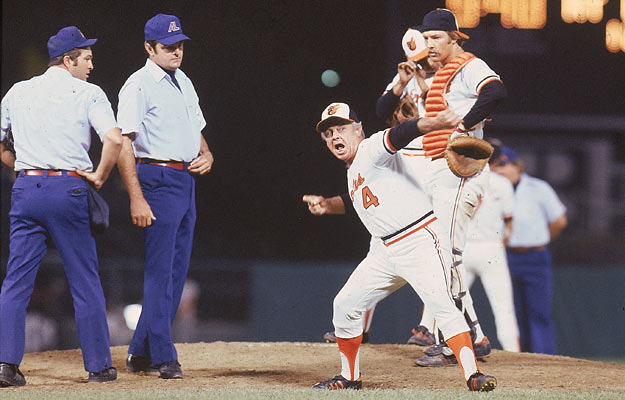
- NBA Announces 2013-2014 Schedule
- Browns Ink Sharknado
- Sharknado A No-Show For Rookie Camp
- Trent Richardson Out Until Training Camp
- Browns Sign Brandon Jackson
- Carrasco Suspended Eight Games
- Browns Add to Wide Receiver Depth with David Nelson
- Browns Need to Learn from Past Draft Mistakes
- Browns Release Chris Gocong and Usama Young
- Browns Missing on Grimes Disappointing, But Not The End
The TCF Forums
- Chris Grant's first 3 drafts
Kingpin74 (Tuesday, January 21 2014 10:13 AM) - The 2014 Offseason Thread
googleeph2 (Tuesday, January 21 2014 9:36 AM) - 2015 Recruiting
furls (Tuesday, January 21 2014 6:57 AM) - Mike Brown
YahooFanChicago (Monday, January 20 2014 11:15 PM) - Movies coming out
HoodooMan (Monday, January 20 2014 9:34 PM) - 2014 Hoops Hockey Hijinx
jpd1224 (Monday, January 20 2014 4:44 PM) - 2014 Recruiting
jclvd_23 (Monday, January 20 2014 2:26 PM) - Wish List - #4 Pick
Hikohadon (Monday, January 20 2014 1:26 PM) - Official- Browns Coach Search/Rumors
OldDawg (Sunday, January 19 2014 6:48 PM) - #1 overall pick Anthony Bennett
TouchEmAllTime (Sunday, January 19 2014 1:28 PM)


